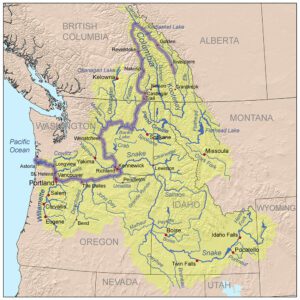
An agreement in principle has been reached regarding key elements of updating the 60-year-old Columbia River Treaty to reflect changing climate and other needs of communities economically dependent on the river and its tributaries.
A White House statement on negotiations issued July 11 noted the importance of the Columbia River to the U.S. economy, generating 40% of the country’s hydropower, irrigating $8 billion in agriculture products and moving 42 million tons of commercial cargo annually.
The U.S. and Canada have managed the waterways jointly for 60 years. In May 2018, the two nations began negotiating to update the treaty for the next 20 years.
White House officials said that in modernizing the treaty they would elevate the voices of U.S. Native tribes and Canada’s indigenous nations. The goal is to also re-balance energy coordination between the two nations, allowing the U.S. to keep more clean hydropower energy at home while giving Canada more opportunities to import from and export to U.S. markets.
The U.S. benefits from pre-planned water storage at Canadian Treaty dams, to help control flooding and protect vulnerable communities, they said.
The tentative deal prompted kudos from Neil Maunu, executive director of the Pacific Northwest Waterways Association (PNWA) in Portland, Oregon, who said there would be many days ahead to ensure the details of a modernized treaty and operations plan meet the requirements of their industry.
“We are excited that safe river navigation, transportation, flood control, and hydropower will remain an efficient and reliable centerpiece to our region and its economy,” he said.
PNWA has challenged the Biden administration’s June 18 announcement regarding creation of the Columbia River Task Force and the release of a report acknowledging the harm that federal dams have continued to inflict on Native America tribes in the region.
White House officials said at the time that the task force advances a historic agreement to work in partnership with tribes and Pacific Northwest states to restore wild salmon populations in the Columbia River Basin and develop a long-term strategy to meet clean energy, transportation and other regional needs.
The Columbia River’s drainage basin is roughly the size of Texas and includes parts of Washington, Oregon, Idaho, Montana, Utah, Wyoming and British Columbia. The treaty’s hydropower operations and management of flood risk provide substantial benefits to millions of people on both sides of the border, and have also yielded environmental benefits in the Columbia River Basin, White House officials said.
